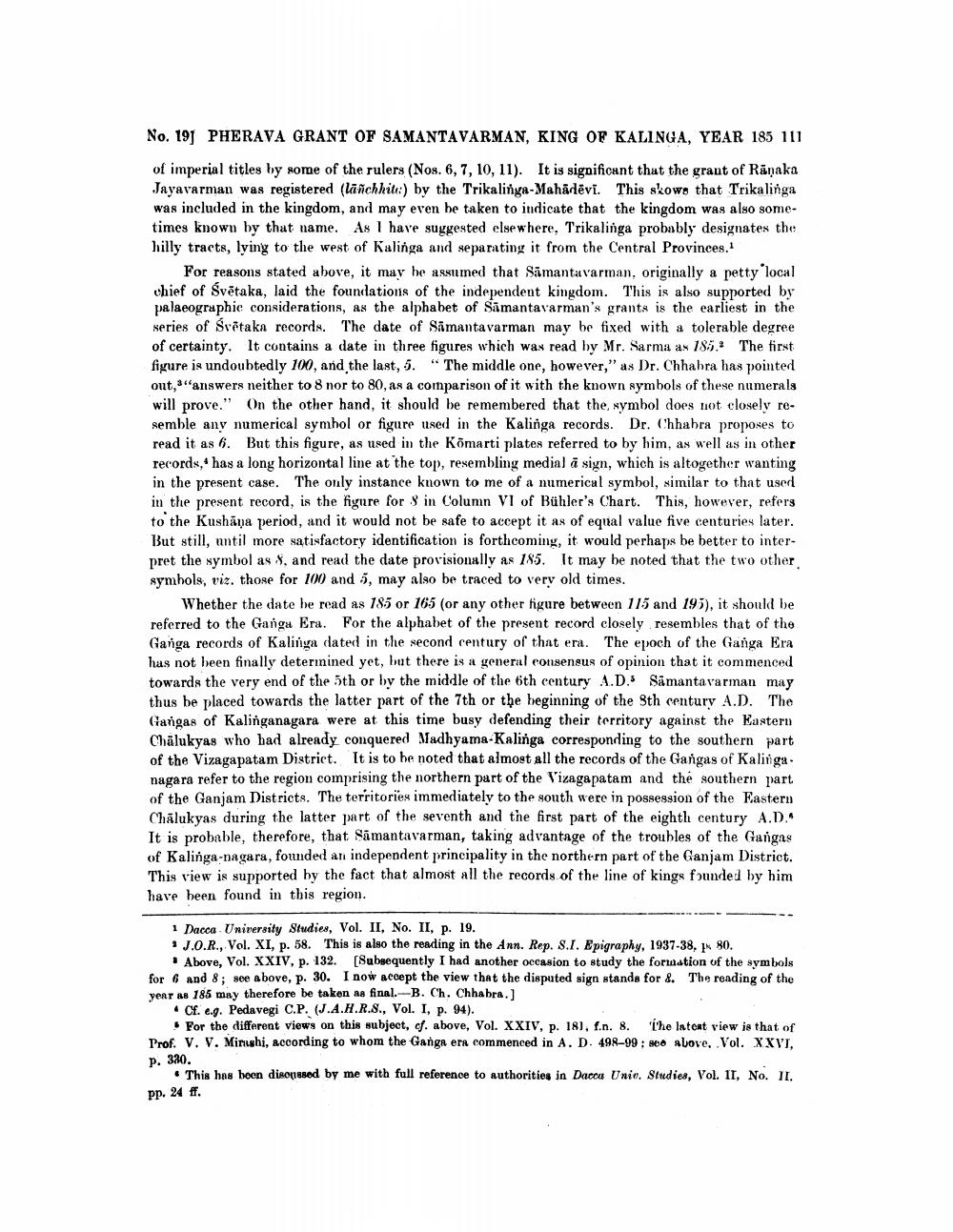________________
No. 19 PHERAVA GRANT OF SAMANTAVARMAN, KING OF KALINGA, YEAR 185 111
of imperial titles by some of the rulers (Nos. 6, 7, 10, 11). It is significant that the grant of Rāņaka Jayavarman was registered (lāñchhit:) by the Trikalinga-Mahadevi. This skowe that Trikalinga was included in the kingdom, and may even be taken to indicate that the kingdom was also some. times known by that name. As I have suggested elsewhere. Trikalinga probably designates the hilly tracts, lying to the west of Kalinga and separating it from the Central Provinces.
For reasons stated above, it may be assumed that Samantavarman, originally a petty local chief of Svētaka, laid the foundations of the independent kingdom. This is also supported by palaeographic considerations, as the alphabet of Samantavarman's grants is the earliest in the series of Světaka records. The date of Samantavarman may be fixed with a tolerable degree of certainty. It contains a date in three figures which was read by Mr. Sarma as 185.2 The first figure is undoubtedly 100, and the last, 5. "The middle one, however," as Dr. Chhabra has pointed out,"answers neither to 8 nor to 80, as a comparison of it with the known symbols of these numerals will prove." On the other hand, it should be remembered that the symbol does not closely resemble any numerical symbol or figure used in the Kalinga records. Dr. Chhabra proposes to read it as 6. But this figure, as used in the Kōmarti plates referred to by him, as well as in other records, has a long horizontal line at the top, resembling medial à sign, which is altogether wanting in the present case. The only instance known to me of a numerical symbol, similar to that used in the present record, is the figure for 8 in Column VI of Bühler's Chart. This, however, refers to the Kushaya period, and it would not be safe to accept it as of equal value five centuries later. But still, until more satisfactory identification is forthcoming, it would perhaps be better to interpret the symbol as X, and read the date provisionally as 185. It may be noted that the two other symbols, viz. those for 100 and 5, may also be traced to very old times.
Whether the date be read as 185 or 165 (or any other figure between 115 and 195), it should be referred to the Ganga Era. For the alphabet of the present record closely resembles that of the Ganga records of Kalinga dated in the second century of that era. The epoch of the Ganga Era has not been finally determined yet, but there is a general consensus of opinion that it commenced towards the very end of the 5th or by the middle of the 6th century A.D. Samantavarman may thus be placed towards the latter part of the 7th or the beginning of the 8th century A.D. "The Gangas of Kalinganagara were at this time busy defending their territory against the Eastern Chalukyas who had already conquered Madhyama-Kalinga corresponding to the southern part of the Vizagapatam District. It is to be noted that almost all the records of the Gangas of Kalinga. nagara refer to the region comprising the northern part of the Vizagapatam and the southern part of the Ganjam Districts. The territories immediately to the south were in possession of the Eastern Chalukyas during the latter part of the seventh and the first part of the eighth century A.D. It is probable, therefore, that Samantavarman, taking advantage of the troubles of the Gangas of Kalinga-nagara, founded an independent principality in the northern part of the Ganjam District. This view is supported by the fact that almost all the records of the line of kings founded by him have been found in this region.
1 Dacca University Studies, Vol. II, No. II, p. 19.
J.O.R., Vol. XI, p. 58. This is also the reading in the Ann. Rep. S.I. Epigraphy, 1937-38, N 80.
Above, Vol. XXIV. p. 132. [Pubsequently I had another occasion to study the formation of the symbols for 6 and 8: see above, p. 30. I now accept the view that the disputed sign stands for 8. The reading of the year as 185 may therefore be taken as final.-B. Ch. Chhabra.)
• Cf. e.g. Pedavegi C.P. (J.A.H.R.S., Vol. I, p. 94).
For the different views on this subject, cf. above, Vol. XXIV, p. 181, f.n. 8. 'l'he latest view is that of Prof. V. V. Mirushi, according to whom the Ganga era commenced in A. D. 498-99 : alove, Vol. XXVI.
p. 320.
• This has been discussed by me with full reference to authorities in Dacou Unie. Studies, Vol. II, No. II. pp. 24 ff.




